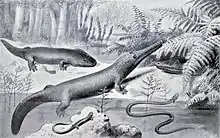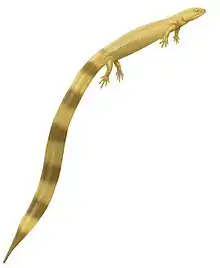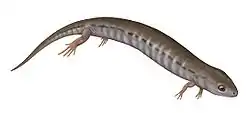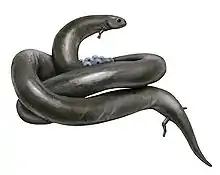Keraterpeton
Keraterpeton is an extinct genus of lepospondyl amphibian from the Carboniferous period of Europe ( Czech Republic ) and North America ( Ohio ).

| Keraterpeton Temporal range: Late Carboniferous | |
|---|---|
| Scientific classification | |
| Kingdom: | Animalia |
| Phylum: | Chordata |
| Subclass: | †Lepospondyli |
| Order: | †Nectridea |
| Family: | †Diplocaulidae |
| Genus: | †Keraterpeton Etheridge, 1866 |
| Species | |
| |
Keraterpeton was a salamander-like creature about 30 centimetres (12 in) long. Its tail was remarkably long taking up two thirds of the animal's total length, and was laterally flattened, presumably to aid in swimming. Its skull was round and short, especially when compared to its Permian relative, Diplocaulus. Its hind legs had five toes, and were longer than the forelimbs, which had only four toes.[1]
Although Keraterpeton had a long body, it did not have more vertebrae than most other amphibian species (15–26 on average).
References
- Palmer, D., ed. (1999). The Marshall Illustrated Encyclopedia of Dinosaurs and Prehistoric Animals. London: Marshall Editions. p. 54. ISBN 1-84028-152-9.
Description
The Keraterpeton was flattened side-ways, which would have helped push itself through the murky waters of the coal swamps in which it lived. The five-toed hind legs were longer than the four-toed fore-feet and the short, rounded skull had eyes set far forward.



